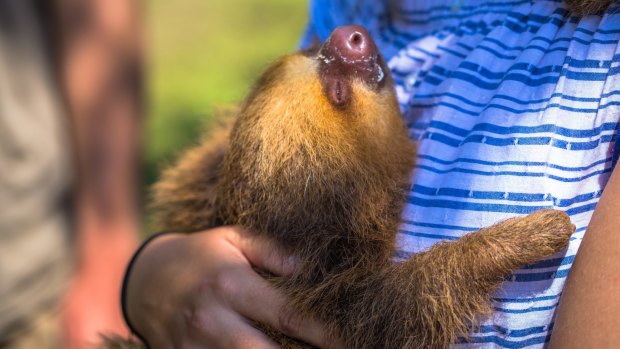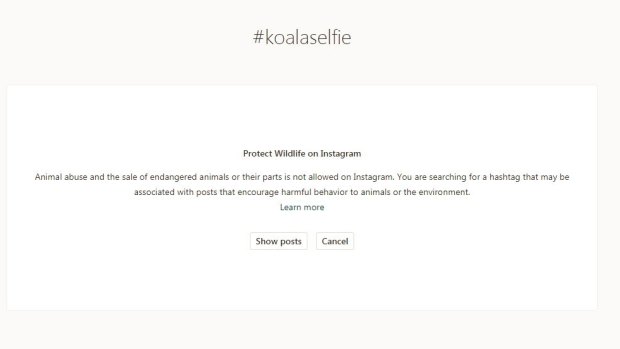By Marwa Eltagouri

Tourist with a sloth.Credit: Shutterstock
Photos of sleepy sloths and curled-up koalas - especially when featured in a selfie - are often considered Instagram gold, guaranteed to attract "likes" and comments.
Instagram officials want to change that.
On Monday, the popular photo-sharing platform announced that anyone searching for those posts using hashtags will be shown a warning that these seemingly innocent photos are often associated with harmful behaviour toward wildlife.

The warning Instagram will now give to users searching for hashtags involving photos taken with animals.
Searching or clicking on hashtags such as #koalaselfie, #elephantride or #dolphinkiss will reveal a pop-up message that reads, "Animal abuse and the sale of endangered animals or their parts is not allowed on Instagram. You are searching for a hashtag that may be associated with posts that encourage harmful behavior to animals or the environment."
Instagram officials said in a statement that the protection and safety of the natural world is "important to us and our global community."
"We encourage everyone to be thoughtful about interactions with wild animals and the environment to help avoid exploitation," the company said.
The introduction of the warning feature is part of a fine line that social networks walk between stopping the spread of negative images and censoring users. In 2012, Instagram banned accounts, images and hashtags dedicated to "glorifying, promoting or encouraging self-harm," such as "Thinspiration" photos that depict extremely thin women to encourage users to lose weight.
Instagram's decision to post warnings on certain wildlife hashtags was made after World Animal Protection approached the social network with research showing a 292 percent increase in the number of selfies with wild animals posted since 2014, according to the animal welfare nonprofit.
More than 40 per cent of those photos showed harmful interactions with the animal, such as hugging, holding, riding or inappropriately handling the animal, the group found.
These photos often support what World Animal Protection considers cruel behaviour by the wildlife entertainment industry, officials said.
Among the most popular photos, for instance, are those depicting a hug from a sloth, said Cassandra Koenen, the group's head of wildlife campaigns.
But sloths, which are arboreal mammals that spend most of their time in trees, are meant to touch down on the ground about once a week.
Sloths that appear in these types of photographs are often in captivity, suffering from irregular diets and temperatures with limited space to move around, she said. Their interactions with chemicals such as insect repellent sparks an allergic reaction that causes bald patches on their skin.
"When they're taken from the trees and forced to interact with humans, it's fearful," Koenen said. "They're constantly looking around to get back into the trees while hugging you."
She said she worked with Instagram to compile a list of about 100 hashtags that will trigger the wildlife warnings. The hashtags were chosen based on the most photographed animal species and the types of interactions the animals had with humans in the photos.
Instagram has not disclosed most of the hashtags, as officials want users to stumble across them on their own, according to National Geographic. Instagram officials also don't want people who purposely post illegal wildlife practices to find ways around the warnings.
Koenen said she hopes the warnings don't shame Instagram users but instead educate them about the circumstances that lead to these type of photographs. She said she hopes people will pause and think before posting an animal selfie or liking someone else's.
"It's about helping people understand: This is what goes into that two-second interaction for you to get that photo," she said. "Is that really the Instagram experience you want?"
"Remember that if you can hug or hold it, or you're baiting it to have that interaction, it's always going to be cruel," she said.
In its Wildlife Selfie Code, World Animal Protection encourages tourists to take photos of wild animals without participating in the wildlife entertainment industry and photograph them in their natural environment, where they are free to move around.
Instagram isn't the only social platform to take a stand on wildlife protection. Last year, travel and restaurant review website TripAdvisor announced it would no longer sell tickets to or generate booking revenue from attractions that did not meet animal-welfare standards.
After consulting with animal rights groups, the company chose to eliminate activities that involve travelers "coming into physical contact with" captive wild animals or endangered species. These activities include riding, swimming and petting. The move built on the company's previous policy, which prohibited bookings involving killing or injuring animals, such as captive hunts and bullfights.
The Washington Post
Sign up for the Traveller newsletter
The latest travel news, tips and inspiration delivered to your inbox. Sign up now.